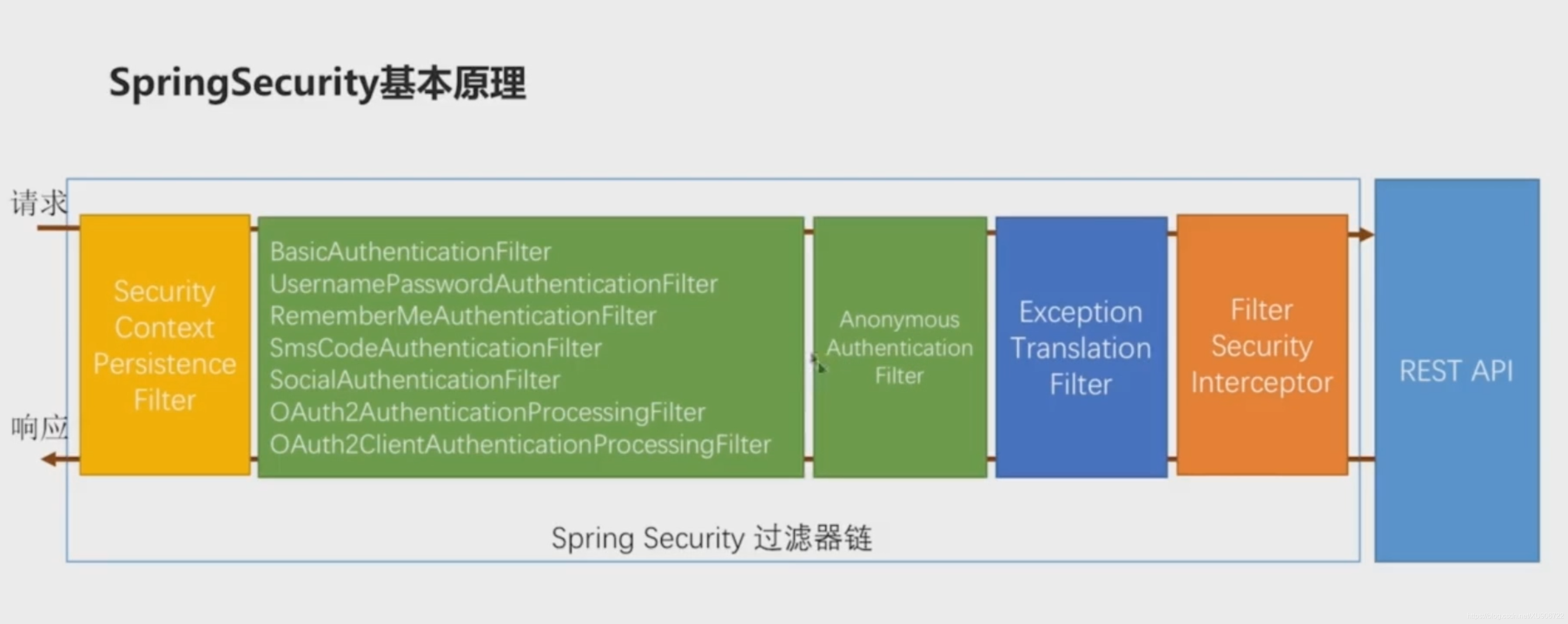流程图


类和接口介绍
- FilterSecurityInterceptor:是整个权限判断流程的入口,包含着请求的相关信息;
- AccessDecisionManager:是一个接口,有一个抽象实现(AbstractAccessDecisionManager)和三个具体实现(AffirmativeBased、ConsensusBased和UnanimousBased)
- AbstractAccessDecisionManager: 该实现中维护者一组AccessDecisionVoter接口;
- AccessDecisionVoter:对每个权限请求进行投票(Spring Security3之前的voter);
- AffirmativeBased:积极的策略,即对于一个权限判断,不管有多少个Voter投不通过,只要有一个投票通过,该权限就通过;该策略是spring默认的判断策略;
- ConsensusBased:共识的策略,即比较投票通过和不通过的票数,以票数最多的为准;
- UnanimousBased:全部通过策略,即对于一个权限判断,不管有多少个投票通过,只要有一个投票不通过,该权限就不通过;
- SecurityConfig:Spring Security的配置文件,用于配置哪些请求放行,哪些请求要经过过滤器以及tokenStoke、enhance等;
- ConfigAttribute:FilterSecurityInterceptor会从SecurityConfig中读取配置信息,并封装成一组ConfigAttribute对象,每个ConfigAttribute对象代表着一个URL它所需要的权限;
- Authentication:封装着当前用户所拥有的权限信息;
- WebExpressionVoter: Spring Security3新增的voter,在web服务中它包含了所有的voter,即它投票过就通过、不过就不通过;
该流程中一共包含三组信息:1. FilterSecurityInterceptor所携带的用户请求信息,2. SecurityConfig配置的权限信息,3. Authentication当前用户所拥有的权限信息。 将这三组权限信息传递给AbstractAccessDecisionManager,它通过AccessDecisionVoter对当前请求是否拥有相应权限进行投票,spring根据设定的投票策略判断当前用户是否拥有他所请求资源的权限。
源码分析
FilterSecurityInterceptor:doFilter方法
public void doFilter(ServletRequest request, ServletResponse response,
FilterChain chain) throws IOException, ServletException {
FilterInvocation fi = new FilterInvocation(request, response, chain);
// 参考下方:invoke方法
invoke(fi);
}
public void invoke(FilterInvocation fi) throws IOException, ServletException {
// 判断当前请求是否已经经过当前过滤器
if ((fi.getRequest() != null)
&& (fi.getRequest().getAttribute(FILTER_APPLIED) != null)
&& observeOncePerRequest) {
// filter already applied to this request and user wants us to observe
// once-per-request handling, so don't re-do security checking
fi.getChain().doFilter(fi.getRequest(), fi.getResponse());
}
else {
// first time this request being called, so perform security checking
if (fi.getRequest() != null) {
fi.getRequest().setAttribute(FILTER_APPLIED, Boolean.TRUE);
}
// 在调用后面的过滤器之前,调用AbstractSecurityInterceptor的beforeInvocation方法
// 参考下方:beforeInvocation方法
InterceptorStatusToken token = super.beforeInvocation(fi);
try {
fi.getChain().doFilter(fi.getRequest(), fi.getResponse());
}
finally {
super.finallyInvocation(token);
}
super.afterInvocation(token, null);
}
}
AbstractSecurityInterceptor: beforeInvocation方法
protected InterceptorStatusToken beforeInvocation(Object object) {
Assert.notNull(object, "Object was null");
final boolean debug = logger.isDebugEnabled();
if (!getSecureObjectClass().isAssignableFrom(object.getClass())) {
throw new IllegalArgumentException(
"Security invocation attempted for object "
+ object.getClass().getName()
+ " but AbstractSecurityInterceptor only configured to support secure objects of type: "
+ getSecureObjectClass());
}
// 获取当前请求应该具有的权限信息
// 参考下方getAttributes方法
Collection<ConfigAttribute> attributes = this.obtainSecurityMetadataSource()
.getAttributes(object);
if (attributes == null || attributes.isEmpty()) {
if (rejectPublicInvocations) {
throw new IllegalArgumentException(
"Secure object invocation "
+ object
+ " was denied as public invocations are not allowed via this interceptor. "
+ "This indicates a configuration error because the "
+ "rejectPublicInvocations property is set to 'true'");
}
if (debug) {
logger.debug("Public object - authentication not attempted");
}
publishEvent(new PublicInvocationEvent(object));
return null; // no further work post-invocation
}
if (debug) {
logger.debug("Secure object: " + object + "; Attributes: " + attributes);
}
if (SecurityContextHolder.getContext().getAuthentication() == null) {
credentialsNotFound(messages.getMessage(
"AbstractSecurityInterceptor.authenticationNotFound",
"An Authentication object was not found in the SecurityContext"),
object, attributes);
}
// 获取当前用户所拥有的权限信息
// 参考下方:authenticateIfRequired方法
Authentication authenticated = authenticateIfRequired();
// Attempt authorization
try {
// 调用AffirmativeBased的decide方法
// authenticated: 封装了当前用户所拥有的权限信息
// object: 封装了当前请求所携带的信息
// attributes: 封装了当前请求应该具有的权限信息
// 参考下方:decide方法
this.accessDecisionManager.decide(authenticated, object, attributes);
}
catch (AccessDeniedException accessDeniedException) {
publishEvent(new AuthorizationFailureEvent(object, attributes, authenticated,
accessDeniedException));
throw accessDeniedException;
}
if (debug) {
logger.debug("Authorization successful");
}
if (publishAuthorizationSuccess) {
publishEvent(new AuthorizedEvent(object, attributes, authenticated));
}
// Attempt to run as a different user
Authentication runAs = this.runAsManager.buildRunAs(authenticated, object,
attributes);
if (runAs == null) {
if (debug) {
logger.debug("RunAsManager did not change Authentication object");
}
// no further work post-invocation
return new InterceptorStatusToken(SecurityContextHolder.getContext(), false,
attributes, object);
}
else {
if (debug) {
logger.debug("Switching to RunAs Authentication: " + runAs);
}
SecurityContext origCtx = SecurityContextHolder.getContext();
SecurityContextHolder.setContext(SecurityContextHolder.createEmptyContext());
SecurityContextHolder.getContext().setAuthentication(runAs);
// need to revert to token.Authenticated post-invocation
return new InterceptorStatusToken(origCtx, true, attributes, object);
}
}
DefaultFilterInvocationSecurityMetadataSource: getAttributes方法
public Collection<ConfigAttribute> getAttributes(Object object) {
final HttpServletRequest request = ((FilterInvocation) object).getRequest();
// 1. SecurityConfig 配置的URL权限信息都会在requestMap中记录
// 2. 判断当前请求中是否有与配置信息匹配,如果匹配的话获取到当前请求应有的权限
for (Map.Entry<RequestMatcher, Collection<ConfigAttribute>> entry : requestMap
.entrySet()) {
if (entry.getKey().matches(request)) {
return entry.getValue();
}
}
return null;
}
AbstractSecurityInterceptor: authenticateIfRequired方法
private Authentication authenticateIfRequired() {
Authentication authentication = SecurityContextHolder.getContext()
.getAuthentication();
if (authentication.isAuthenticated() && !alwaysReauthenticate) {
if (logger.isDebugEnabled()) {
logger.debug("Previously Authenticated: " + authentication);
}
return authentication;
}
authentication = authenticationManager.authenticate(authentication);
// We don't authenticated.setAuthentication(true), because each provider should do
// that
if (logger.isDebugEnabled()) {
logger.debug("Successfully Authenticated: " + authentication);
}
SecurityContextHolder.getContext().setAuthentication(authentication);
return authentication;
}
AffirmativeBased:decide方法
public void decide(Authentication authentication, Object object,
Collection configAttributes) throws AccessDeniedException {
int deny = 0;
for (AccessDecisionVoter voter : getDecisionVoters()) {
int result = voter.vote(authentication, object, configAttributes);
if (logger.isDebugEnabled()) {
logger.debug("Voter: " + voter + ", returned: " + result);
}
switch (result) {
case AccessDecisionVoter.ACCESS_GRANTED:
return;
case AccessDecisionVoter.ACCESS_DENIED:
deny++;
break;
default:
break;
}
}
if (deny > 0) {
throw new AccessDeniedException(messages.getMessage(
"AbstractAccessDecisionManager.accessDenied", "Access is denied"));
}
// To get this far, every AccessDecisionVoter abstained
checkAllowIfAllAbstainDecisions();
}
}





















 485
485











 被折叠的 条评论
为什么被折叠?
被折叠的 条评论
为什么被折叠?








